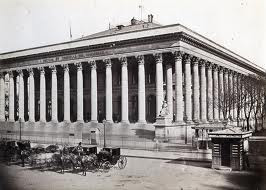The Photographs Collection is intended for the study of architecture and related subjects such as interior design, topography, landscape, construction and planning.
It contains over 1.5 million images in a wide range of formats that includes negatives, prints, transparencies, postcards and digital files. The images include works from the earliest photographers and architects to the present day.
In two and a half hours it was only possible to see a tiny selection. What we saw was an extraordinary selection of some of the most well known masters of photography, many of them unknown to me before.
My preference and interest in photography has focused on images of people. My favourite are documentary or portrait photographers. To begin with I thought I was going to find it difficult to summon enthusiasm for architectural photography, so I was pleasantly surprised when I discovered exciting and inspirational work. Eric de Maré, Lucien Hervé, Hélène Binet for starters.
This evening I was introduced to even more photographers and concepts that got me excited and wanting to know more about their work and practices.
One of the first surprises was that most of the early architectural photographers were actually architects. It makes sense but I had never thought about it before. Architects understand how to draw buildings correctly, how to correct converging verticals. These skills transfer comfortably to photography. They knew how to use the bellows and lens, moving them independently to correct these distortions. Today we use tilt and shit lenses.
Others transferred comfortably from painting and drawing to photography.
One of these was Edouard Baldus, who came to Paris to study painting. After ten years with little success as a painter, he abandoned his easel and picked up a camera. He was quickly recognised as a photographer with a unique ability to combine aesthetic sensitivity with technical accuracy. This won him a contract with the French government to document the Roman and Medieval buildings of France.
 Many of the early images included more of the environment creating beautiful images of the building or structure, the environment and often included people.
An example of this is shown in Samuel Bourne's photo (right). A statement on things as they exist. An accurate record of the place. Many of the items in RIBA archives have details and notes on the back of the prints outlining how the photographer wanted the image processed. How it was to be cropped. Areas specified where dodging and burning was to take place. Even cloning out details. Photoshop has not brought us anything new, just an easier way to do it.
Many of the early images included more of the environment creating beautiful images of the building or structure, the environment and often included people.
An example of this is shown in Samuel Bourne's photo (right). A statement on things as they exist. An accurate record of the place. Many of the items in RIBA archives have details and notes on the back of the prints outlining how the photographer wanted the image processed. How it was to be cropped. Areas specified where dodging and burning was to take place. Even cloning out details. Photoshop has not brought us anything new, just an easier way to do it.
In the early 20th century Eric de Mare was one of Britain's most influential architectural photographers, he focused on industrial structures this work became known as "functional tradition." His images were carefully composed, everything within the frame had been considered. He was hugely influential on architectural photography taking it outside of the confines of the architects realm, appealing to the wider public. An example of his work below shows how striking his images are. I love the juxtaposition of old and new and how it is beautifully framed by the trees. An image like this is still striking in the 21st century.
By the 60's and 70's the style of architectural photography was more graphic in style and focused on detail shots. A classic example of this type of work is by Judith Turner. This modernist approach was controversial just like everything else in this period. It reminds me a little of the clothing fashions of the time. When I look at this image I think of Mary Quant.
Another even less popular style of architectural photography appeared around 1969- 1970. A body of work titled Manplan was commissioned from a group of photojournalists. This was far removed from any previous architectural photography, largely shot on 35mm film, lots of people and showing life as it really was. Often taken under grey skies or wet weather these grainy images were not popular with the architects who felt these images reflected negatively on their work.
The evening passed really quickly so it was a very quick look at photographs from the 21st century. Richard Bryant is one of the most widely known and respected architectural photographers at present. Most of the images we are seeing now are beautiful crisp, glossy, coloured images.





No comments:
Post a Comment